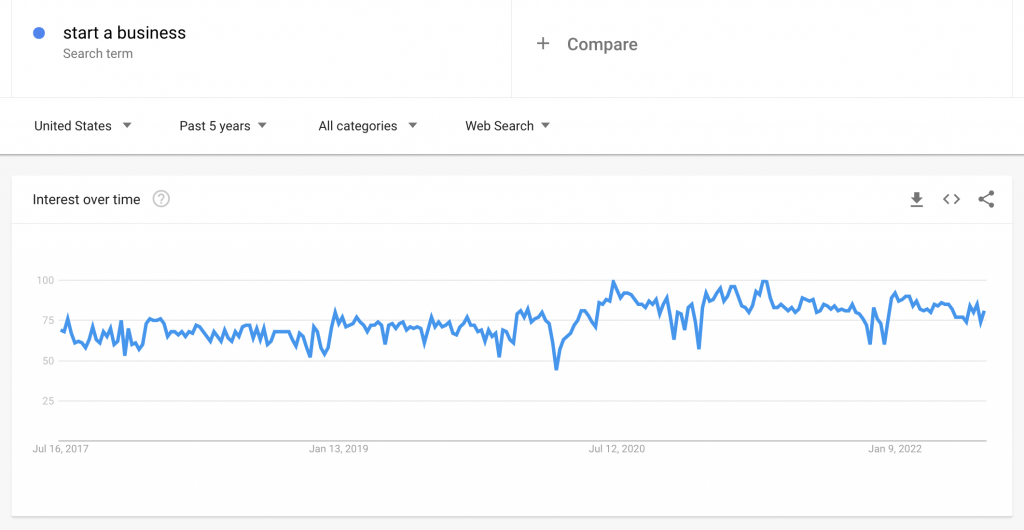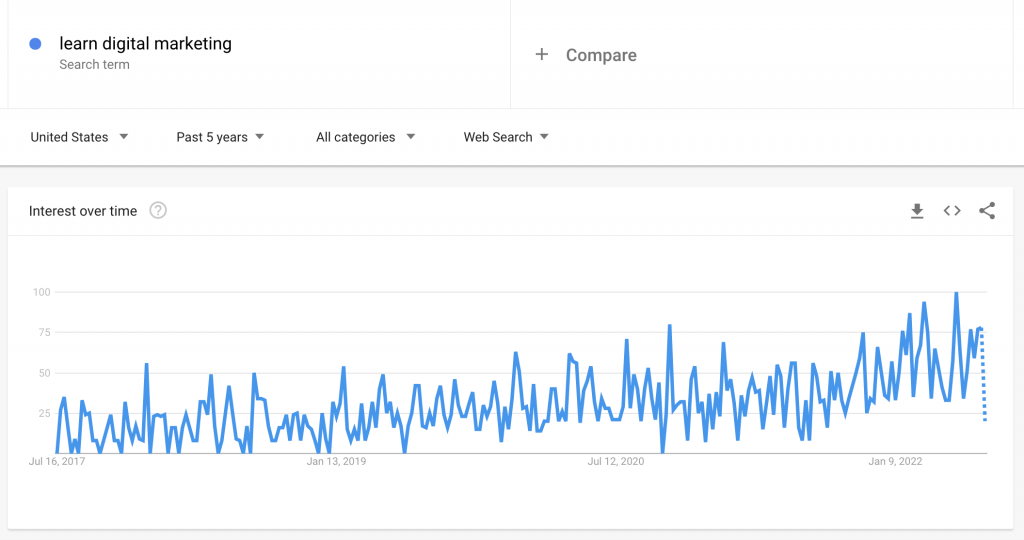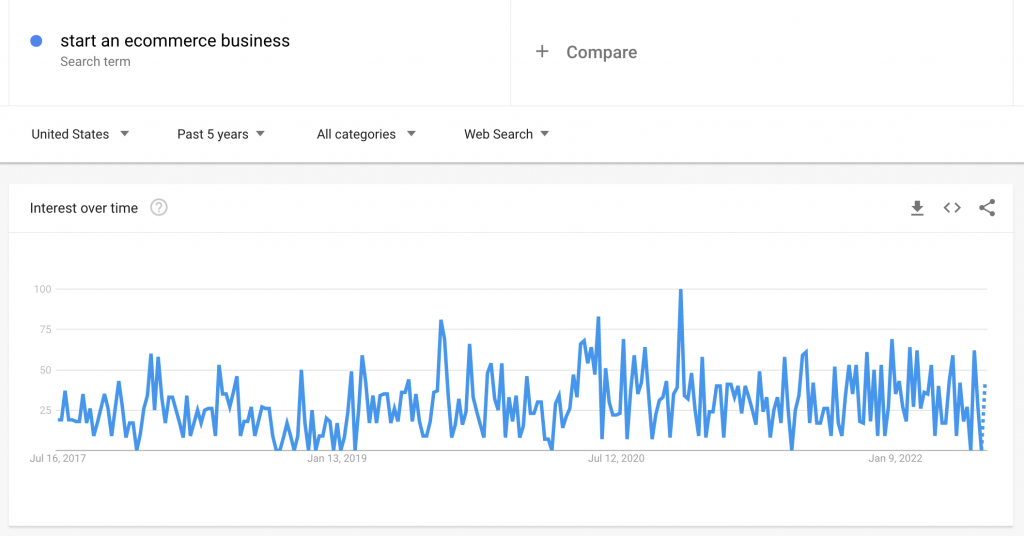- How to Do SEO for Affiliate Marketing in 6 Steps (In 6 Months) - October 19, 2024
- Ecommerce SEO: The Ultimate Guide - October 19, 2024
- How to Grow Your Ecommerce Business Exponentially: 11 Growth Hacks - October 19, 2024
If you think about “entrepreneurship” you probably think about big names like Elon Musk, Aristotle Onassis, or Mark Cuban. But entrepreneurial lifestyles also have much humbler manifestations across the world.
We started this blog over 4 years ago and have grown it into a 7-figure business through affiliate marketing, our agency, and our software tool, GrowthBar. We use that money to continue investing in expanding the business, all while we work remote from anywhere in the world! It’s not quite as glamorous, but it’s just as fun!
Entrepreneurship is a common dream for many, especially in the midst of the freelancer revolution and the Great Resignation. We’ve all questioned the value of returning to the office and working for a boss.
Interest in “starting a business” has increased over 33% over the last 5 years.

Today’s entrepreneur might be a former 9-5er turned digital nomad, independent fitness guru, or a programmer with a SaaS idea.
But no matter the execution, entrepreneurship is a fun, wild, and fascinating journey.
So, just how many Americans are entrepreneurs, and how many of them actually succeed? I’ll cover that and way more in this roundup of the best entrepreneurship statistics.
Also read:
– The Ultimate List of SaaS Statistics
– The Ultimate List of Landing Page Statistics
– The 8+ Best Ways to Launch Your Business
Table of Contents
Must-Know Entrepreneur Statistics
1. In 2021, there were 360 new American entrepreneurs for every 100,000 people.
The highest rate of new US entrepreneurship in the last 20 years was in 2020 (380/100,000). Regardless, 360, or a rate of 0.36%, is still significantly high.
Past years in the 2010s didn’t surpass 0.33%. Our take? The slight drop from 2020’s rate to 2021 may have been due to companies welcoming back employees after the brunt of COVID-19.
2. 31 million Americans are entrepreneurs as of 2019, but that number is likely higher.
Statistics take some time to catch up. Given the uptick in new businesses after COVID-19, we estimate Babson’s American entrepreneur numbers might be slightly outdated. But if we stay on the safe side and assume 31 million, you’re looking at just under 10% of Americans as entrepreneurs. Are you one of them? You’re one in 10.
3. 65% of American businesses fail within ten years.
And 20% fail within the first two years. As Investopedia puts it so nicely, you should take all these numbers with a grain of salt. It’s hard to keep a business alive, no doubt about it – but failure might mean different things to you.
Additionally, not every business signs up on paper for these big government agencies to learn about them every year. Another helpful resource is the BLS, which describes only 20% of businesses that opened in 2016 remained open a year later.
4. There has been a 420% increase in interest in digital marketing over the last 5 years
Interest in “learning digital marketing” is up 420% over the last 5 years. Digital marketing is the backbone of digital entrepreneurship, so this helps support the explosion in entrepreneurship, particularly post-COVID-19.

5. The average USA entrepreneur makes $79,415 per year.
Not bad for being your own boss, right?
6. Small businesses make up 99.1% of all businesses in the USA.
By small, we mean under 500 employees (which might not seem small at all). The US Small Business Administration Office of Advocacy estimates that 31.7 million American businesses are small businesses, while about 20,000 are large businesses (over 500 employees).
7. 19% of small businesses in the US have any paid employees.
Labor is expensive, as most small businesses would agree. But we doubt 81% of them do everything on their own. They might have partnerships to split the work, outsource to agencies, or hire freelancers instead of hiring formal employees.
8. 68% of customers would support small businesses and entrepreneurs if they provided online shopping.
Brick-and-mortar entrepreneurs can’t prospect new leads without coming online, and 68% of customers agree, according to GoDaddy.
9. 29% of entrepreneurs choose their path to be their own boss.
Other reasons to pursue entrepreneurship include boredom, unhappiness working as an employee, and embracing a passion.
Demographics for US Entrepreneurs
10. Immigrants are 80% more likely to start a business than native Americans.
This key finding from an MIT study debunks the ignorant narrative that immigrants take American jobs. On the contrary, they create more jobs.
11. Women own 42% of American businesses.
You go, girl! On top of that, women-led businesses grew by a whopping 114% from 1997 to 2017. The trend continues even in less developed countries like Vietnam, Uganda, and Ghana, where women make up 30-50% of entrepreneurs.
12. Around half of all entrepreneurs hold a college degree.
While studying for and receiving a degree are worthy pursuits, they do not necessarily determine whether you’ll be successful as an entrepreneur. Mark Zuckerberg is a prime example of this. He was a student at Harvard when he first launched Facebook but dropped out to work on his business full time.
Around 96% of entrepreneurs finished high school, but only 51.4% received a bachelor’s degree. With remote learning and certifications that innovate beyond the traditional college model, it’s more accessible now than ever to obtain some sort of education. And with a growing tech industry on the rise for entrepreneurs, it’d be prudent to take advantage of it.
13. Baby Boomers and Gen Z make up most of America’s entrepreneurs.
Where are the millennials? It depends on who you ask. Guidant’s survey found only 7% of entrepreneurs identified as millennials, while StartupNation found a much higher number of millennial entrepreneurs. Both agree that Gen Z entrepreneurs will grow in numbers as well.
14. Only 6% of entrepreneurs are Black
However, Blacks make up 12.6% of the United States population according to the census. So there remains a deficit in the number of Black-owned businesses.
Industry and Skill Statistics for Entrepreneurs
15. The AI industry’s growth rate to rise to 33.2% between 2020 and 2027.
Many entrepreneurs are hopping on AI innovation due to its high-speed growth. People want convenience and accuracy and are willing to pay for it. That’s why Semrush also draws attention to 75% of executives who agree they’ll go out of business if they don’t adopt AI.
Also read: The 8+ Best AI Writing Tools on Earth
16. Retail is the largest industry for entrepreneurs in 2022.
We should specify that eCommerce makes up most of the 15% of entrepreneurs in the retail industry. Other common industries included restaurants, business services, residential and commercial services, and health and beauty. It’s unsurprising given how prolific Shopify and Amazon have become.

17. 54% of entrepreneurs say communication skills are vital to their team.
Guidant Financial also cites teamwork, customer relationships and management, and critical thinking as other in-demand skills.
Conclusion
As you now know from this ultimate list, being an entrepreneur can be tough. There’s a high failure rate and the odds are even more stacked against you as an entrepreneur of color.
But the future also looks bright for entrepreneurs. Corporate Americans yearn to break free from the 9 to 5 and location chains they’ve worn for so long — that mindset produces a lot of hard-nosed drive. On top of that, technology is making it easier than ever before to become an entrepreneur. There are countless online resources for starting your business and growing it faster than ever before.
Also read:




